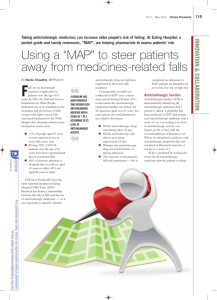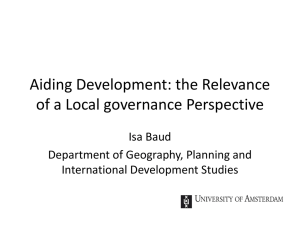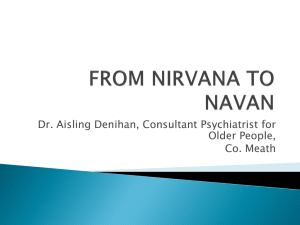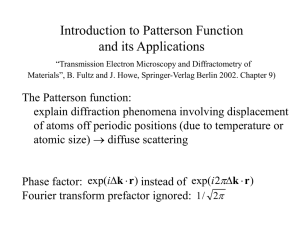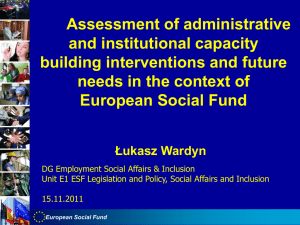Grande_ConvegnoUVA_7novembre2014_ISS [modalità
advertisement
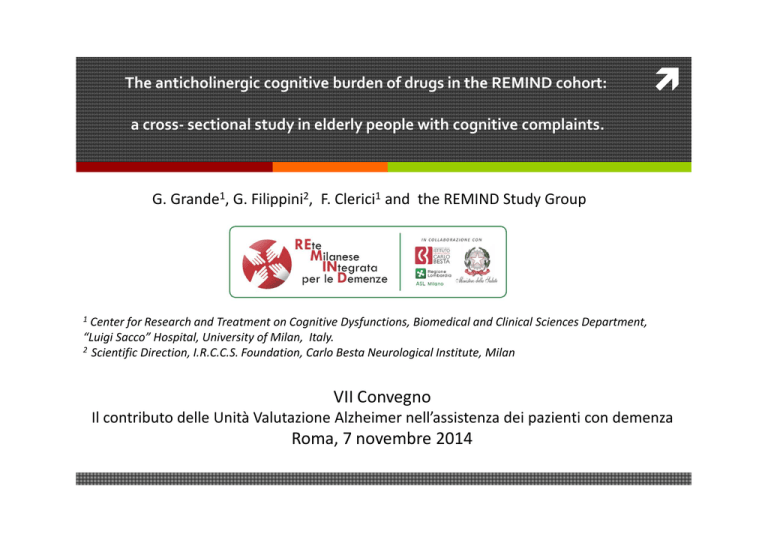
The anticholinergic cognitive burden of drugs in the REMIND cohort: a cross- sectional study in elderly people with cognitive complaints. G. Grande1, G. Filippini2, F. Clerici1 and the REMIND Study Group 1 Center for Research and Treatment on Cognitive Dysfunctions, Biomedical and Clinical Sciences Department, “Luigi Sacco” Hospital, University of Milan, Italy. 2 Scientific Direction, I.R.C.C.S. Foundation, Carlo Besta Neurological Institute, Milan VII Convegno Il contributo delle Unità Valutazione Alzheimer nell’assistenza dei pazienti con demenza Roma, 7 novembre 2014 Background 1: Why studying medication with anticholinergic activity? Evidence are not conclusive to impute to drugs with a anticholinergic action a negative impact on cognition. Some studies demonstrate an association between anticholinergic use and worsening in cognitive performance of people1,2,3,4. Some longitudinal observational studies5,6 do not support this hypothesis. 1. 2. 3. 4. Different definition of anticholinergic effect. Different setting (primary care vs. hospital). Different study design (cross-sectional vs. longitudinal cohort study). Different aged of studied population. References: 1 Carriere I. et al., Drugs with anticholinergic properties cognitive decline and dementia in general population. Arch internal medicine, 2009. 2 Boutsani et al., “impact of anticholinergics on the aging brain: a review and practical application”, aging health, 2008. 3 Bottigi KA et al., “Long term cognitive impact of anticholinergic medications in older adults”. Am J Geriatr Psychiatry, 2006. 4 Cambpell N. et al., The cognitive impact of anticholinergics: a clinical review. Clin Interv Aging, 2009. 5 Cambpell et al., use of anticholinergics and the risk of cognitive impairment in an African American population, Neurology, 2010. 6 Whalley et al., “anticholinergic drugs in late life: adverse effects on cognition but not on progress to dementia”, Journal of Alzheimer Disease, 2012 Background 2: The regulatory framework in Milan Background 3: • The REMIND study, funded by the Ministry of Health and coordinated by the Istituto Carlo Besta of Milan, is a 3-year (20132015) population-based pragmatic prospective cohort study. • To implement the PDTAR shared with GPs, Memory Clinics (MCs), Community-based Specialist Services (CSSs) and Social Care Community Services • To evaluate the effectiveness of the PDTAR in promoting: • primary care prevention • appropriateness of patients' referral to specialists • timely diagnosis • coordination and integration of health and social care plan • optimization of resource allocation. Background 4 : the 7 districts in the Milan HA 353 GPs, 14 MCs, 15 CSSs, 19 Social Care Community Services District 7 GPs: 35 MC: 1 Social care community service: 1 District 6 GPs: 38 MC: 1 Social care community services: 2 District 2 GPs: 73 CSSs: 4 MCs: 3 Social care community services: 4 District 3 GPs: 54 CSSs: 3 MC: 2 Social care community services: 5 District 5 GPs: 70 CSSs: 4 MCs: 5 Social care community services: 2 District 4 GPs: 66 CSSs: 2 MC: 1 Social care community services: 4 District 1 GPs: 16 CSSs: 2 MCs: 2 Social care community service: 1 Aim of the present study To evaluate the use of drugs with anticholinergic properties in the cohort of the REMIND study. Method • Design: Cross sectional study • Setting: Primary care (353 GPs) • Enrolment: April 2013- March 2014 • Inclusion criteria: 4246 consecutive subjects aged over 45 years with first cognitive complain (perceived by the subject and/or by a relative and/or by the GP) and living in Milan • Assessment: clinical evaluation, drug history, MMSE performed by trained GPs • Outcome: cognitive impairment as defined by a MMSE correct score <24 The Anticholinergic Cognitive Burden (ACB) score 1 The ACB can be categorized as: 1. no burden, or ACB 0 (receiving no drugs with ACB score of 1, 2, or 3), 2. mild burden, or ACB 1 (receiving at least one drug with an ACB score of 1) and 3. severe burden, or ACB 2 (receiving at least one drug with an ACB score of 2 or 3, or receiving more than 3 drugs with ACB score of 1). The original list was modified by excluding the drugs that are not actually marketed in Italy according to the Agenzia Italiana del Farmaco (http://www.agenziafarmaco.gov.it/) . 1 Cai X et al., Alzheimer’s and dementia, 2013 Tab. 1: Baseline characteristics of the whole sample of subjects and by ACB score Tot N 4246 ACB score 0 N 3152 ACB score 1 N 927 ACB score 2 N 167 Age ≤ 70 yrs, N (%) 826 (19,5) 683 (21,7) 121 (13,1) 22 (13,2) 71-80 yrs, N (%) 1850 (43,6) 1244 (39,5) 338 (36,5) 66 (39,5) > 80 yrs, N (%) 1570 (37,0) 1225 (38,9) 468 (50,5) 79 (47,3) Mean ± SD Median (range) 77 ± 8,2 78 (45-100) 76,4 ± 8,4 77 (45-100) 78,9 ± 7,4 80 (51-99) 78,4 ± 7,8 79 (51-94) P< 0,0001 Gender Female, N (%) 2821 (66,4) 2066 (65,6) 623 (67,2) 132 (79) Male, N (%) 1425 (33,6) 1086 (34,5) 304 (32,8) 35 (21) P= 0,001 ≤ 5 yrs 1428 (33,6) 1019 (32,3) 348 (37,5) 61 (36,5) 6 – 10 yrs 1465 (34,5) 1077 (34,2) 332 (35,8) 56 (33,5) > 10 yrs 1353 (31,9) 1056 (33,5) 247 (26,6) 50 (29,9) Mean ± SD 8,81 ± 4,2 9.0 ± 4,3 8,3 ± 4,0 8,6 ± 4,3 8 (0-26) 8 (0-26) 8 (0-24) 8 (1-26) MMSE score P< 0,0001 P= 0,037 ≥ 24, N (%) 3400 (80,1) 2551 (80,9) 724 (78,1) 125 (74,9) < 24, N (%) 846 (19.9) 601 (19,1) 203 (21,9) 42 (25,1) Mean ± SD 26,05 ± 3,71 26,2 ± 3,6 25,8 ± 3,75 25,3 ± 4,5 27 (3,3-30) 27 (3,3-30) 27 (5,6-30) 27 (8-30) Median (range) P< 0,0001 P= 0,001 Education Median (range) P P = 0,001 Tab. 2: Crude OR and 95% CI of scoring below 24 at the MMSE according to the ACB score Crude OR 95 % CI ACB score 0 1 ACB score 1 1,19 1,00- 1,42 ACB score 2 1,43 1,00- 2,05 Tab. 3 OR and 95% CI of scoring below 24 at the MMSE in relation to the ACB score adjusted for demographic variables OR Age ≤ 70 yrs 95 % CI 1 71- 80 yrs 1,63 1,24- 2,13 > 80 yrs 3,39 2,61- 4,4 Gender Male Female Education > 10 yrs 1 0,91 0,77- 1,08 1 6-10 yrs 2,01 1,63- 2,49 < 5 yrs 2,49 2,02- 3,08 ACB score 0 1 1 1,01 0,84- 1,23 2 1,3 0,89- 1,89 Tab. 4 OR and 95% CI of scoring below 24 at the MMSE in relation to baseline ACB Score, stratified by age. <71 yrs OR ACB score 0 1 2 95% CI 1 71-80 yrs OR 95% CI 1 >80 yrs OR 95% CI 1 1,33 0,72- 2,47 1,17 0,87- 1,57 0,95 0,74- 1,22 1,02 0,23- 4,47 1,29 0,71- 2,35 1,32 0,80- 2,18 Tab. 5 OR and 95% CI of scoring below 24 at the MMSE in relation to baseline ACB Score, stratified by education. <5 yrs OR ACB score 0 1 2 5-10 yrs 95% CI 1 OR 95% CI 1 >10 yrs OR 95% CI 1 1,15 0,88- 1,5 0,96 0,71- 1,3 1,45 0,97- 2,18 1,12 0,63- 1,99 1,62 0,90- 2,92 1,62 0,74- 3,54 Discussion About one quarter of elderly subjects with first cognitive complain received in the primary care setting at least one drug with anticholinergic action. The association between the use of anticholinergic drugs and the impairment in cognition, measured with the MMSE, adjusted for demographic variables, although not statistically significant might be clinically relevant from a public health standpoint. Strenghts of the study The large sample size allows to make inferences that reflect the real world clinical practice. Moreover, the present study deals with a very relevant clinical point and might contribute to understand the risk factors associated with cognitive decline. The primary care setting is relevant for taking decision in a public health perspective. Limitations of the study The observational nature: the present study can’t prove neither a causal link nor the direction of the association between the use of anticholinergic drugs and the impairment in cognition. Some information about some variables that could influence the cognitive performance of the patients are missing, including the duration of anticholinergic treatment. Indication bias: when a treatment serves as a marker for a clinical characteristic or medical condition taht triggers the use of the treatment and that, at the same time, increases the risk of the outcome under the study. Future perspective In the context of the cross- sectional study it will be possible to investigate the role of the ACB score in the subitems of the MMSE. Moreover, in those subjects sent to the MCs, we will correlate the ACB score with the neuropsychological assessment. Since this study in a part of a 3-year population-based prospective cohort study, we will evaluate the association between the ACB score and the diagnosis of dementia made by specialists. Acknowledgments Pamela Moser Director District 1 Milan HA Saverio Chirchiglia Director District 4 Milan HA Gemma Lacaita, Donatella Sghedoni Department Primary Care Milan HA Mario Montani, Vito Pappalepore, Ugo Tamborini, Luciana Bovone GPs Graziella Filippini, Michela Morbin, Pietro Tiraboschi, Fabrizio Tagliavini IRCCS Istituto Neurologico Besta Francesca Clerici, Giulia Grande Ospedale L. Sacco Gabriella Bottini, Stefania Basilico Ospedale Niguarda Elio Scarpini IRCCS Fondazione Cà Granda Vincenzo Silani IRCCS Auxologico Elisabetta Farina, Francesca Saibene IRCCS S Maria Nascente Don Gnocchi Cinzia Negri Chinaglia Ospedale Pio Albergo Trivulzio Claudio Bilotta, Sergio Bressi, Cristina Cusi, Angela Di Giovanni, Carlo Montaperto, Simona Schioppa Istituti Clinici di Perfezionamento Domenico Arenella Irene Tramacere Coordination Center Statistical Support Grants of the Italian Ministry of Health (RF-2010-2318922) and of the Milan HA (Clinical Governance 2013) Thanks! http://intranet.asl.milano.it/_asl/Alzheimer/Default.htm
